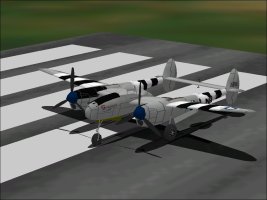There were some discussions recently about Merlin P-40s, so just after screwing up a flight test for my A6M2, I decided to look over my own Merlin P-40s that were done a few years back. The P-40F was pretty much as I remembered with RAF type markings.

The US Army Air Forces version was just a little different from what I remembered. It is shown in the directory listing as a P-40F-5 and the description shows a much later ""In Service" date than the plain P-40F.

That wasn't the unusual part. The surprising part was that it was a long-tail variant and I didn't remember building one though I must have done so.
I had to take a look back at the RAF version just to confirm the difference in the length of the tail. The easiest way is to note where the leading edge of the vertical fin meets the fuselage. If it is a short tail, it will meet at about the same place as the horizontal stabilizers. If it is a long tail, it will meet quite a ways back.
The next switch back to the USAAF version confused me even further. It kept the paint scheme of the RAF aircraft. I have seen this happen when the models were identical in differently named aircraft in the directory, but had not seen it before when the models were different as they clearly are in this case.

The next screenshot is just to show in one image that it is both a long tail variant and a Merlin P-40 with the odd Radiator exhaust area.

How often do you build something and then forget all about it? I must be getting really old and forgetful.
I can tell from the state of the instrument panel that this particular aircraft never finished testing.
- Ivan.

The US Army Air Forces version was just a little different from what I remembered. It is shown in the directory listing as a P-40F-5 and the description shows a much later ""In Service" date than the plain P-40F.

That wasn't the unusual part. The surprising part was that it was a long-tail variant and I didn't remember building one though I must have done so.
I had to take a look back at the RAF version just to confirm the difference in the length of the tail. The easiest way is to note where the leading edge of the vertical fin meets the fuselage. If it is a short tail, it will meet at about the same place as the horizontal stabilizers. If it is a long tail, it will meet quite a ways back.
The next switch back to the USAAF version confused me even further. It kept the paint scheme of the RAF aircraft. I have seen this happen when the models were identical in differently named aircraft in the directory, but had not seen it before when the models were different as they clearly are in this case.

The next screenshot is just to show in one image that it is both a long tail variant and a Merlin P-40 with the odd Radiator exhaust area.

How often do you build something and then forget all about it? I must be getting really old and forgetful.
I can tell from the state of the instrument panel that this particular aircraft never finished testing.
- Ivan.























